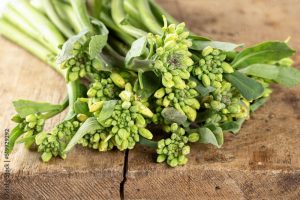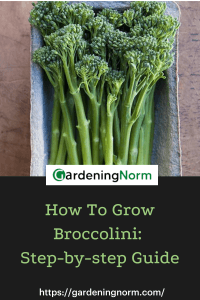Broccolini – How To Grow the Best: Step-by-step Guide
One of the pleasures of gardening is the opportunity to cultivate certain vegetables that are unique and not widely known like broccolini.
If you’re interested in a challenge or just want to try some new vegetables, growing broccolini from seeds is a great alternative to consider. They’re similar in needs for growth to broccoli, and only a few differences.
Broccolini is an ideal choice for those with short growing seasons. It also gives you another chance to harvest If you plant them earlier during the time of the year.
A common scene in the world of fine dining the broccolini plant can cultivate as a food source or provide the basis for your community.
Table of Contents
ToggleWhat is a Broccolini?


Broccolini is a hybrid type of broccoli or broccolini is a hybrid of European that has small florets that look similar to broccoli. It’s a mix of American broccoli and Chinese Kale, also known as Gai Lan, commonly referred to by the name Chinese broccoli.
If you’re curious this is a natural phenomenon and has proven to be a profitable product of research into horticulture and the development of different cultivars of Brassica Oleracea.
Broccolini is a naturally crossed plant that can be grown by seed or through transplants. It has the great characteristics of its parents, such as the round and green flowers and the slim stalks of the Chinese Kale.
Broccolini can be a trademark and it is referred to in different ways by different seeding companies. The confusion surrounding the name is the biggest weakness because people aren’t sure of the proper way to refer to them collectively.
Consider this example in which broccolini(r) is the name used by the company that was the first to develop them, which is Mann Packing Company.
Synergene Seed & Technology in Salinas, California also crossed the same parent vegetable and called the result the sweet little broccoli. This variety of broccoli has the same parent and similar qualities, but with distinct names.
If you’re looking to purchase broccolini seeds on the internet You will be flooded with the various names for this unique vegetable, including:
- Aspabroc
- Asparation (Sanbon Inc.)
- Tenderstem
- Baby broccoli
- Bimi
- Broccoletti
- Broccolette
- Sprouting broccoli
- Brokali
- Sweet baby broccoli (Synergene Seed & Tech)
Due to the limited supply on the market, broccolini costs more than normal broccoli or baby broccoli. This is the reason that it is only available at the premium markets and fine dining establishments. It’s even described as an exquisite vegetable.
Imagine what an uncommon gardener you will become if you begin growing this tasty plant in the delicious vegetable garden.
Broccolini Varieties That You Can Grow
Even hybrids such as broccolini come in varieties. If you’re interested in growing they are available. Thanks to numerous trials of crossbreeding broccoli with Chinese Kale New varieties have been discovered. They include:
1. Apollo is a type that is known as a heavy producer. It can grow from 24 to 28 inches in height and width. It produces side shoots even after the main head is harvested, ensuring a constant crop throughout the growing season.
Apollo is a sweet variety. Apollo variety is sweeter and has soft stalks that are perfect for salads. It is also a big feeder, which means you will require fertilizing more than normal. It’s also adaptable and fast to grow when it is in cool temperatures.
Here are a few of the growing details about it:
- The temperature of the soil to the germination process: 55degF to 75degF
- Germination time: 5 to 17 days
- Seed Depth: 1/4 of an inch
- Seed spacings: 4 to 6 inches
- Row Spacing between 18 and 36 inches
- Day to mature: 50 to 60 days
- Light requirements: Full sun
2. Atlantis is a different kind of Brokali breed that is different from Apollo. It’s also a large producer, which will make it appear as if you’re getting tiny broccoli heads with each flower.
Atlantis variety is sweet and has a fresh taste that is a blend of the flavor of broccoli as well as asparagus. It doesn’t require pinching to get an increased yield. You can start seeds indoors, and you can grow multiple varieties from spring until autumn.
Here are some of its ever-growing demands:
- The temperature of the soil to the germination process:55degF to 85degF
- Germination time: 7 to 10 days
- Seed Depth: 1/4 of an inch
- Space between seeds: Between 18-24 inches
- Row Spacing between 30 and 36 inches
- days to maturation: 33 days
- Light requirements: Full sun
- Season Cool season
3. Broccolini (Aspabroc) is the first bred variety developed by Sakata Seed Company and Mann’s. It has a slightly sweet and spicy flavor which is more pronounced when cooked. Broccolini is the name of the brand that has been sold in markets that are local to Northern as well as Central America for years and distributed by Mann’s and Sakata Seed Company.
- The temperature of the soil to the germination process: 50degF to 85degF
- Germination time: 7 to 10 days
- Seed thickness: 1/4 of an inch
- Space between seeds: Between 18-24 inches
- Row Spacing 30-36 inches
- Day to mature: 50 days
- Light requirements: Full sun
- Season Cool season
4. Royal Tenderette The Royal Tenderetteis a multi-stemmed selection that is commonly called broccoli varieties in the marketplace. It is different from other varieties. It is sweet and has a crisp taste that is best eaten raw and dipped in various sauces. It is prolific in producing florets and can provide 2 to three harvests in a month, and is the ideal choice for growing in containers.
- The temperature of the soil for germinating: 50degF to 85degF
- Germination time: 12 to 14 days
- Seed thickness: 1/4 of an inch
- Space between seeds: between 18 and 24 inches
- Row Spacing 30-36 inches
- Dates to maturation: 50 to 60 days
- Light requirements: Full sun
- Season Cool season
5. Montebello is a different broccolini variety with an earthy sweet flavor. It’s best cooked or sauteed. It is best harvested in autumn and late summer.
Here is some additional information about the growing variety of HTML0:
- The temperature of the soil to allow the germination process: 70degF
- The period of germination: 10 to 21 days
- Seed thickness: 1/4 of an inch
- Space between seeds: between 18 and 24 inches
- Row Spacing 2 feet
- Day to mature: 70 to 75 days
- Light requirements: Full sun
- Season Cool season
6. Burgundy is one of the broccolini varieties that is distinctive due to its purple flowers. It has a sweet taste and crunchy stems that are perfect for cooking of any kind.
Here is additional information about this variety of vegetable which resembles flowers:
- The temperature of the soil for the germination process: 70degF
- The period of germination: 10 to 21 days
- Seed Depth: 1/4 of an inch
- Seed spacing between 18 and 24 inches
- Row Spacing 2 feet
- Day to mature: 37 to 45 days
- Light requirements: Full sun
- Season Cool season
Best Growing Conditions For Broccolini
Broccolini is a cool-season plant that has the same growth needs as broccoli. The only distinction it has over broccoli is that it has florets instead of heads, and the stems and leaves can be eaten. Due to its kale characteristics, the leaves and stems can be cooked and eaten as kale.
Each variety of broccolini has particular requirements for growth, but they all fall within the same group.
Below are the most suitable conditions for growing broccolini by SEED
- Soil conditions A moist, well-drained soil that has a pH between 6.0 to 7.0.
- Temperature specifications 50degF to 85 deg. F
- Germination time is 7 to 21 days based on the type of grass.
- Lighting needs The sun must be full
- Requirements for water 1 – 2 inches of water per week
- Days of maturation from 33 days to 75 days
Planting The Broccolini Seeds
Broccolini seeds are sown indoors for up to 6 weeks before being transplanted into the garden. Note that not all varieties of broccolini can reproduce in the same way. Check the label on the broccolini seeds you purchase.
Additionally, the majority of broccolini varieties boast an average of around 80% germination rate, meaning you can put two seeds in one hole.
Here’s how you can start germinating indoors.
Materials:
- Compost
- Seedling tray
- Shovel
- Potting mix
- Misting spray containing water
Directions:
- Mix a cup of compost in your non-fertilized soil mix. If your soil mix already has fertilizer then you can avoid adding compost.
- Mix the potting mix into the tray that you are using for the seedlings.
- Utilizing an object, poke the soil with a tiny hole measuring around 1/4 inch.
- Place the seeds into the hole. Then take a handful of potter mix and lightly sprinkle it on the holes.
- Mist the newly planted seeds gently to prevent washing off the seeds.
- Be sure to water them each week and when the soil gets too dry.
- It will take 10 to 21 days or more to allow the seeds to sprouting broccoli. When the seedlings are 3-4 inches in height and are placed in a sun-lit area in your home. If you’re using a grow light expose them to sunlight for 16 hours per day, and then let them cool for eight hours.
- As they begin to develop up to 3-8 leaves, you can begin making them harder before transplanting. Place the tray of seedlings outdoors, in the partially shaded area over 5-7 days.
Transplanting Broccolini:
- Prepare the soil in the ground by adding organic matter and compost tea. Be sure the soil’s pH ranges from 6.0 or 7.0 and that the soil is well-drained and aerated.
- Transfer the broccolini seedlings to a distance between 1 and 2 feet between them.
- It is recommended to water the transplants well and over their roots with 1 to 2 inches of mulch.
Fertilizing Broccolini
Since it is a big eater, broccolini requires an ongoing intake of nutrients. After three weeks of transplanting, spray compost tea or add a fertilizer that is low in nitrogen for your broccolini plants. It is not enough to require fertilizer, however, it will appreciate a regular feed now and then.
The roots are unable to extract nourishment from the soil if the pH of the soil goes over 6.0 to 7.0. If the soil becomes acidic, it is possible to include wood ash in the soil. But if the soil is too alkaline, you can make use of soil acidifiers, such as elemental sulfur.
Pinching or Pruning Broccolini
Tipping or pinching is an effective pruning technique to stimulate branching and encourage the growth of fresh shoots. For broccolini, it delays flowering and also encourages the growth of edible shoots.
Many varieties such as Atlantis don’t require pinching. As with broccoli, pinching could be a possibility for broccolini generally because there isn’t a large head of broccoli that has to develop.
Pest and Disease Control
Like many species of plants, broccolini could be the victim of pest and fungal diseases.
To ensure general control of pests and diseases It is suggested that sprinkle your broccolini with dilute Neem oil when they have been transplanted.
Here are a few of the more common ailments to be on the lookout for:
1. Alternaria Leaf spot is an ailment that is common to the cole variety that is manifested as tiny reddish-brown spots on the leaf. It also affects the tender stems of broccolini and causes them to wither.
The spores that cause this illness typically multiply and breed in hot and humid conditions and spread through water splashes as well as air.
2. Clubroot is an infection of fungal origin in the soil which causes the plant roots belonging to the Brassica family to swell. The swelling blocks the proper absorption and absorption process of nutrients as well as moisture from the soil. The disease may cause slow growth and wilt patches that appear on the leaf of broccolini.
3. Damping off is a very common fungal illness that occurs in broccolini seedlings when they begin to lose their vigor with no explanation. It’s the result of a fungus that thrives when there’s too much moisture, or changes in temperatures (below the 68-degree mark) F) and nitrogen levels in the soil.
4. White blister (Albugo candida) is another infectious disease that belongs to the Brassica family. It is a cause of blanched blisters that appear on florets, leaves, and the head of different varieties as well as hybrids, that are spore-filled.
Many pests can cause damage to your broccoli during its growing period. They include the following bugs and larvae
5. Aphids are tiny sap-sucking insects that enjoy eating tender and crunchy broccoli stems. They are available in various shades, including white, red, green black, peach, and.
Aphids that are infested with aphids could cause plants to become dehydrated. They also leave an oily residue on leaves, which attracts other insects, and can even lead to fungal diseases.
6. Cabbage loopers, also known as worms are tiny green worms that have white stripes along their sides. They are capable of causing holes in the heads, leaves, and florets of the cabbage and broccoli varieties. They may cause your broccolini to be mangled leaves and veins that are barely alive.
7. Flea Beetles are tiny Black beetles that feed on leaves of broccoli as well as other varieties of vegetables. They can overwinter in the soil and infest growing plants once the early spring appears.
8. Leafminers are tiny insects that eat leaves from within, making mazes-like tunnels. They aren’t visible at the surface because they’re hidden beneath that outer layer of leaves.
They don’t cause life-threatening injuries to broccolini however they could influence the photosynthesis and growth of the florets.
9. Slugs are slow, but deadly pests found in the cole variety of vegetables. They feed on leaves, causing large holes that could eventually cause them to die. Slugs can attack at night and you can create traps to keep them away from your broccoli.
Disease
Keep an eye out for signs of illness and implement preventative measures like regular weeding to prevent the overcrowding of plants as well as stop excessive moisture from accumulating.
Black Leg
This fungus, which produces dark spots on leaves typically affects the cole family of crops. It is prevalent in humid and warm conditions and may also remain in the soil or on plants and plant debris.
Since this fungus is easily spread and is not able to be treated with an effective cure, it’s crucial to eliminate infected plants and eliminate plant debris after the season.
Mulching seeds, thinning seedlings, weeding, and allowing leaves to dry completely between watering reduces the risk of getting a disease.
Black Rot
This is a bacterial illness that causes a foul smell and darkens the veins of leaves which causes the foliage to die and wilt. It is prevalent in wet, warm weather and is particularly frequent in gardens with a lot of people.
Prevention is the best method to control black rot because it is difficult to successfully treat. To minimize risk, plant crops in soil that drains well Rotate regularly, avoid over-watering and eliminate all plants infected.
Downy Mildew
The disease can cause brown or yellow spots on leaves, which grow in the white mold when wet. It can slow growth or lead to loss of leaves. Get rid of and destroy any plants affected by downy mildew.
You can lower the risk of getting a disease by regularly weeding and thinning to lessen the overcrowding, and increase airflow.
It is also possible to spray plants in the early morning hours to allow the plant a chance to cool down during the day’s heat and make them less prone to mold.
Harvesting Broccolini
To enjoy the most flavor out of your broccolini, ensure that you pick it before the flowers begin to turn yellow. You can pick the flower when they begin to emerge to ensure that you get another harvest.
The maturity dates for each variety vary. Therefore, ensure that you adhere to the guidelines printed on the labels of your broccolini seed. Every broccolini floret is edible since the leaves are modeled after features of kale and its florets are modeled after its broccoli-related features.
Do You Cut The Stems of Broccolini?
Like broccoli, the stems are harvested together with the broccoli florets. They are equally delicious as the florets and are often used in meals. The taste of the stems is evident when they are cooked or roasted.
How To Store Broccolini?
Keep your broccolini in the refrigerator without placing them in a bag that is sealed. Make sure to dry the florets first as moisture within the florets may make them rot faster.
They can be placed into a spinner for salads to remove the excess water faster. They’ll be stored in the refrigerator for up to seven days.
Tips in Growing Broccolini
- You can pick your main head, in the beginning, to stimulate side shoots to develop to ensure a consistent harvest through the fall.
- The flowers that measure between 1 and 2 inches wide are ready to be harvested just before they bloom or begin to wilt.
- Avoid watering foliar to keep from attracting bugs and fungal diseases.
- Always apply preventive pest and fungal control such as neem oil, or soap for insecticides.
- Be sure to dry the broccolini for a couple of days before planting them into the soil.
Final Thoughts
Growing broccolini in the seed will help you improve your skills in gardening as it is an uncommon vegetable.
You could be the first one to grow broccolini in your area. You never know, you could find yourself awestruck by this vegetable for its flavor and earnings potential.
We hope that this blog has given you a better understanding of the amazing baby broccoli. If you found this article interesting, remember to send it to your friends.
Frequently Asked Questions (FAQs)

👉 Pin It
Is there a difference between broccoli and broccolini?
Broccolini isn’t an enormous head, and it tastes sweeter than broccoli. Its taste is sweeter than. The stems and leaves of broccolini are edible because it’s a hybrid of Chinese broccoli and kale. Certain varieties of broccolini don’t require pinching.
What does a broccolini taste like?
Broccolini is sweet and has some peppery notes. But, the overall flavor differs with each kind. Certain varieties may be sweeter while others may be more earthy.
Is broccolini the same as broccoli rabe?
Although they may appear similar, broccoli rabe isn’t related to the family of broccoli. It is closer to turnips. It has a slightly bitter taste, which is different from its cousin, broccoli.
Why the price of broccolini is so high?
Broccolini is costly due to an insufficient supply. It’s not widely distributed due to the absence of conventional facilities to propagate it in a larger amount.
There is also a problem regarding the reputation of the plant because it is described in various ways, which can confuse numerous gardeners and customers alike.
How long should you stem broccoli?
It is possible to steam broccolini for between 3 and 5 minutes. If you would like the stems to soften then wait 5 minutes before switching off the heat. But, you can get a slight crunch by steaming it for three minutes.
What are you eating broccoli with?
It is typically sauteed with olive oil and garlic and then seasoned by adding salt and pepper. It’s cooked similar to asparagus or broccoli because of its delicate stems.
What part of broccolini do we eat?
In addition to root vegetables and the hard stem at the base, You can also eat the stems and leaves as well as the florets and leaves. It’s a versatile plant that can be cooked roast or steam, stir-fry, and then add to salads.
Which is the most nutritious value of broccolini?
Broccolini is high in the following minerals and vitamins:
- Vitamin C
- Vitamin A
- Vitamin E
- Calcium
- Folate
- Iron
- Potassium
What is the best way to clean broccolini?
The best method of cleaning broccoli is to soak it in a vinegar-water solution for just a couple of minutes. When you pull the broccolini up it will reveal tiny insects that have hidden within the florets. Rinse the broccolini with fresh water afterward.
What are the benefits of eating broccoli?
Broccolini is rich in fiber that aids in digestive health. It also has a filling effect that helps you feel full quickly, without the need for excessive carbohydrates. The magnesium and calcium in the diet can aid in lowering blood pressure and also improve the health of your heart.
Disclaimer: GardeningNorm is a participant in the Amazon Services LLC Associates Program and may receive a commission if you purchase a product via a link on this page.. However, this does not impact our reviews.Read the full disclosure here.




